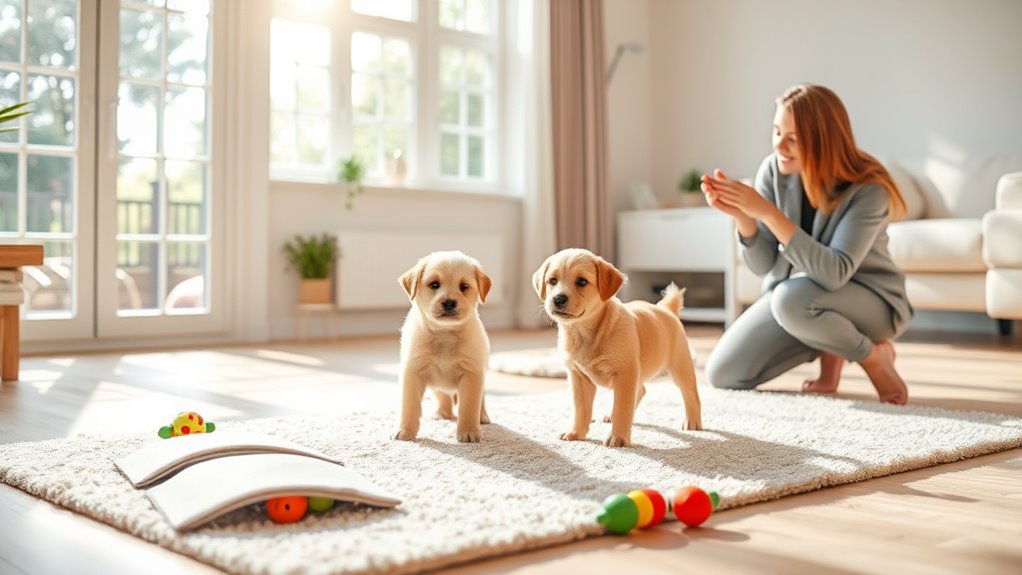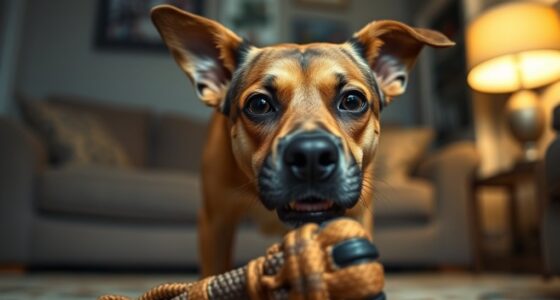To prevent indoor accidents, establish a consistent potty routine by taking your dog outside at regular intervals, praising them when they eliminate outdoors. Use a crate appropriately to give your dog a safe space, and don’t punish accidents—focus on thoroughly cleaning to remove odors that attract them back. Supervise closely and respond calmly to indoor mishaps with positive reinforcement. Staying patient and consistent will help your pup develop good habits; if you keep these tips in mind, you’ll find the process becomes smoother over time.
Key Takeaways
- Establish a consistent potty routine by taking your dog outside regularly and praising successful eliminations.
- Use a properly sized crate to provide a safe space and reinforce housebreaking.
- Clean indoor accidents thoroughly with odor-neutralizing products to prevent repeat incidents.
- Supervise your dog closely and recognize signs they need to go, like sniffing or circling.
- Practice patience and positive reinforcement to help your dog learn appropriate elimination habits.

House training is an essential step in helping your new puppy or adult dog become comfortable and well-behaved in your home. One of the most effective methods to achieve this is through crate training, which provides your dog with a safe, den-like space that encourages them to hold their bladder and bowels. When you introduce a crate, make sure it’s appropriately sized—large enough for your dog to stand, turn around, and lie down comfortably. Use the crate consistently, and never use it as a punishment. Instead, think of it as a cozy retreat that your dog will want to keep clean.
Establishing a reliable potty routine is key to preventing accidents indoors. Take your dog outside at regular intervals—first thing in the morning, after meals, after play sessions, and before bedtime. Consistency is paramount; sticking to a schedule helps your dog understand when it’s time to go. Keep the trips outside short and positive. Use a specific spot for elimination and praise your dog enthusiastically when they go. This positive reinforcement encourages them to repeat the behavior in the future.
Consistent potty breaks, positive reinforcement, and a designated spot help your dog learn where and when to go.
When your dog has an accident indoors, avoid punishment. Instead, clean the area thoroughly to eliminate odors that might attract them back to the same spot. Proper cleaning techniques are crucial for effective odor removal and to prevent repeat accidents. Consistent supervision is essential during this phase. Keep a close eye on your dog, especially during the initial training days, and watch for signs that they need to go—sniffing, circling, or heading toward the door. If you catch them in the act indoors, calmly interrupt with a gentle “no” or a distraction, then immediately take them outside to their designated potty spot. If they go outside, reward them with praise or treats to reinforce the behavior.
Patience is your best ally during house training. Remember, accidents are normal and part of the process. Stick to your routine, keep a positive attitude, and avoid getting frustrated. Consistency in crate training and maintaining a steady potty routine will develop good habits over time. As your dog learns to associate going outside with positive experiences, accidents indoors will become fewer. With dedication and clear boundaries, your dog will soon understand where and when they’re supposed to go, making your home a cleaner, happier place for both of you.
Frequently Asked Questions
How Long Does It Typically Take to House Train a Puppy?
It typically takes about 4 to 6 months to house train a puppy, but it varies. You’ll want to use crate training to help control accidents and establish routines. Consistently reward your puppy with positive reinforcement when they go outside, and be patient as they learn. Some puppies pick it up faster, while others may need more time. Stay consistent, and you’ll see progress over time.
What Are Signs My Dog Is Ready to Be House Trained?
Like a young sapling ready to grow, your dog shows signs of readiness for house training. Watch for consistent signals such as staying dry longer, alertness to bathroom cues, and reliability during walks. These signs of readiness indicate it’s the right training timing. When your pup naturally seeks appropriate spots and can hold it, you’re on the path to successful house training. Be patient and celebrate small victories along the way.
Can Older Dogs Be House Trained Successfully?
Yes, older dogs can be house trained successfully. While age-related challenges like slower learning or existing habits may make training take longer, your consistent effort is key. Focus on positive reinforcement, establish a routine, and be patient. With steady training and understanding of their needs, your older dog can learn proper house habits just as well as a puppy.
How Should I Handle Setbacks During House Training?
When setbacks happen during house training, stay patient and avoid punishment. Focus on setback management by calmly re-establishing routines and reinforcing positive behaviors. Make sure to supervise your dog closely, and take them outside frequently to prevent accidents. Remember, consistency and patience are key. If setbacks persist, consider consulting a trainer or veterinarian for tailored advice. Keep your cool, and your dog will learn with time and encouragement.
Are Certain Breeds Easier to House Train Than Others?
Some breeds are easier to house train than others, mainly due to breed differences and temperament factors. For example, intelligent and keen-to-please breeds like Border Collies tend to pick up training faster, while stubborn breeds like Bulldogs may require more patience. You might find that certain breeds are naturally more receptive to house training, making the process smoother. Keep in mind, consistency and positive reinforcement go a long way, regardless of breed.
Conclusion
By following these house training basics, you set yourself up for a smoother journey with your furry friend. Remember, every pet has their own pace, and gentle guidance goes a long way. With patience and consistency, you’ll create a harmonious home where accidents are just a distant memory. Keep your approach positive and understanding, and you’ll both enjoy the happy, clean space you’ve worked so hard to create.









